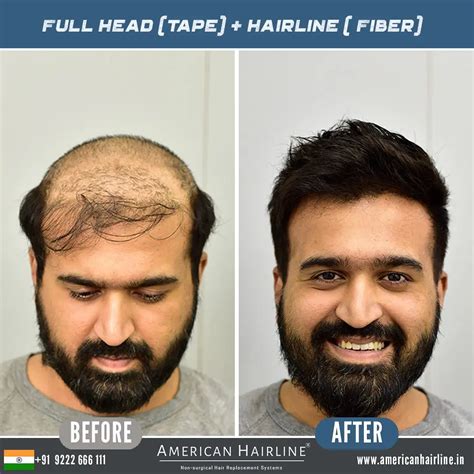Hair loss is a common problem affecting millions of men worldwide. It can be caused by various factors, including genetics, aging, hormonal changes, and medical conditions. While hair loss is not life-threatening, it can have a significant impact on a man’s self-esteem and confidence.

Fortunately, there are numerous hair replacement options available for men, each with its own benefits and drawbacks. In this comprehensive guide, we will explore the seven most popular hair replacement methods, helping you make an informed decision about the best option for you.
1. Hair Transplants
- How it works: Hair transplantation involves surgically removing healthy hair follicles from a donor area (usually the back of the scalp) and implanting them into the balding areas.
- Benefits: Natural-looking results, permanent solution, high success rates.
- Drawbacks: Expensive, time-consuming, potential scarring.
2. Hair Replacement Systems
- How it works: Hair replacement systems are non-surgical, prosthetic hairpieces that are attached to the scalp using adhesives or clips.
- Benefits: Convenient, affordable, wide range of styles and colors.
- Drawbacks: Can be uncomfortable or irritating, requires regular maintenance.
3. Scalp Micropigmentation
- How it works: Scalp micropigmentation involves depositing tiny pigments of color into the scalp, creating the illusion of hair follicles.
- Benefits: Low maintenance, non-invasive, cost-effective.
- Drawbacks: Semi-permanent, may not be suitable for all hair types.
4. Laser Hair Therapy
- How it works: Laser hair therapy uses low-level lasers to stimulate hair growth by promoting blood circulation and collagen production in the scalp.
- Benefits: Non-invasive, painless, FDA-approved.
- Drawbacks: Requires multiple treatments, may not be effective for all.
5. Minoxidil and Finasteride
- How it works: Minoxidil is a topical medication applied to the scalp that helps slow down hair loss and promote hair growth. Finasteride is an oral medication that inhibits the production of DHT, a hormone that contributes to hair loss.
- Benefits: Affordable, accessible over-the-counter.
- Drawbacks: Limited effectiveness, potential side effects (e.g., scalp irritation, sexual dysfunction).
6. Platelet-Rich Plasma (PRP) Therapy
- How it works: PRP therapy involves injecting a concentrated solution of platelets into the scalp to stimulate hair growth.
- Benefits: Non-invasive, may promote thicker, fuller hair.
- Drawbacks: Requires multiple treatments, may not be suitable for all.
7. Natural Hair Growth Alternatives
- How it works: Various natural remedies, such as essential oils, herbal extracts, and lifestyle changes (e.g., stress reduction, healthy diet) have been anecdotally reported to promote hair growth.
- Benefits: Affordable, non-invasive.
- Drawbacks: Limited scientific evidence, may not be effective for all.
How to Choose the Right Hair Replacement Option for You
The best hair replacement option for you will depend on your individual needs, budget, and preferences. Consider the following factors:
- Type of hair loss: Determine the underlying cause of your hair loss to narrow down your options.
- Cost: Hair replacement methods vary significantly in price.
- Maintenance: Some options require regular appointments or treatments, while others are more low-maintenance.
- Personal preferences: Choose a method that aligns with your lifestyle and desired results.
Tips for Choosing a Skilled Hair Loss Specialist
- Credentials: Look for a hair loss specialist with appropriate medical training and experience.
- Reputation: Read reviews and testimonials from previous clients.
- Transparency: Ask about the success rates and potential risks of different procedures.
- Personal rapport: It’s important to feel comfortable with your hair loss specialist and have open communication.
Conclusion
Hair loss can be a frustrating and confidence-draining experience. However, with the numerous hair replacement options available today, you can regain your confidence and restore your appearance. By carefully considering the different methods, consulting with a skilled hair loss specialist, and following the appropriate aftercare instructions, you can achieve the best possible results and live a full and active life with a healthy head of hair.
Tables
Table 1: Hair Replacement Costs
| Method | Average Cost |
|---|---|
| Hair Transplants | $4,000-$15,000+ |
| Hair Replacement Systems | $500-$3,000 |
| Scalp Micropigmentation | $1,000-$4,000 |
| Laser Hair Therapy | $300-$1,200 per session |
| Minoxidil | $30-$60 per month |
| Finasteride | $20-$60 per month |
| PRP Therapy | $500-$2,000 per treatment |
Table 2: Hair Replacement Times
| Method | Time to Results | Maintenance |
|---|---|---|
| Hair Transplants | 6-12 months | 1-2 checkups per year |
| Hair Replacement Systems | Immediate | Monthly adjustments |
| Scalp Micropigmentation | 2-4 sessions | Annual touch-ups |
| Laser Hair Therapy | 6-12 months | Monthly treatments |
| Minoxidil | 4-6 months | Daily application |
| Finasteride | 6-12 months | Daily pill |
| PRP Therapy | 3-6 months | Quarterly treatments |
Table 3: Hair Replacement Success Rates
| Method | Success Rate |
|---|---|
| Hair Transplants | 85-95% |
| Hair Replacement Systems | 70-80% |
| Scalp Micropigmentation | 60-70% |
| Laser Hair Therapy | 50-60% |
| Minoxidil | 30-50% |
| Finasteride | 20-30% |
| PRP Therapy | 10-20% |
Table 4: Advantages and Disadvantages of Hair Replacement Methods
| Method | Advantages | Disadvantages |
|---|---|---|
| Hair Transplants | Natural-looking, permanent | Expensive, time-consuming |
| Hair Replacement Systems | Convenient, affordable | Can be uncomfortable, requires maintenance |
| Scalp Micropigmentation | Low maintenance, non-invasive | Semi-permanent, not suitable for all hair types |
| Laser Hair Therapy | Non-invasive, painless | Requires multiple treatments, may not be effective for all |
| Minoxidil and Finasteride | Affordable, accessible over-the-counter | Limited effectiveness, potential side effects |
| PRP Therapy | Non-invasive, may promote thicker hair | Requires multiple treatments, may not be suitable for all |
| Natural Hair Growth Alternatives | Affordable, non-invasive | Limited scientific evidence, may not be effective for all |
